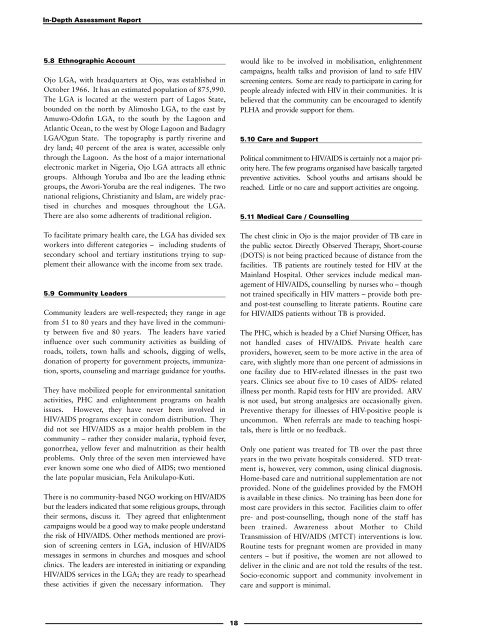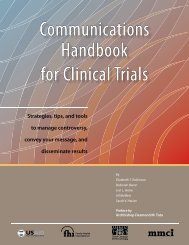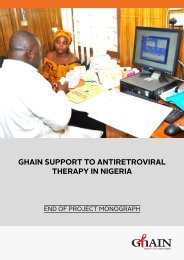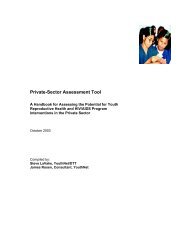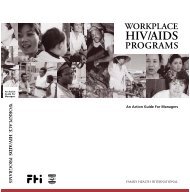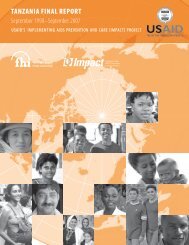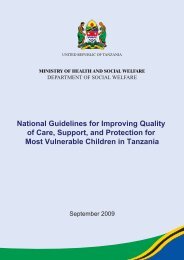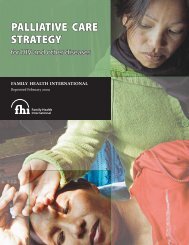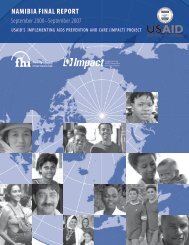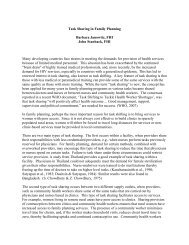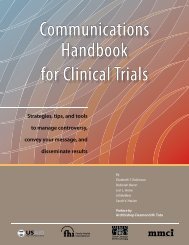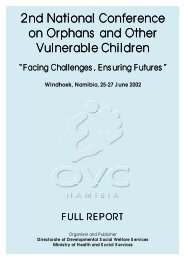Lagos State, Nigeria - Family Health International
Lagos State, Nigeria - Family Health International
Lagos State, Nigeria - Family Health International
Create successful ePaper yourself
Turn your PDF publications into a flip-book with our unique Google optimized e-Paper software.
In-Depth Assessment Report<br />
5.8 Ethnographic Account<br />
Ojo LGA, with headquarters at Ojo, was established in<br />
October 1966. It has an estimated population of 875,990.<br />
The LGA is located at the western part of <strong>Lagos</strong> <strong>State</strong>,<br />
bounded on the north by Alimosho LGA, to the east by<br />
Amuwo-Odofin LGA, to the south by the Lagoon and<br />
Atlantic Ocean, to the west by Ologe Lagoon and Badagry<br />
LGA/Ogun <strong>State</strong>. The topography is partly riverine and<br />
dry land; 40 percent of the area is water, accessible only<br />
through the Lagoon. As the host of a major international<br />
electronic market in <strong>Nigeria</strong>, Ojo LGA attracts all ethnic<br />
groups. Although Yoruba and Ibo are the leading ethnic<br />
groups, the Awori-Yoruba are the real indigenes. The two<br />
national religions, Christianity and Islam, are widely practised<br />
in churches and mosques throughout the LGA.<br />
There are also some adherents of traditional religion.<br />
To facilitate primary health care, the LGA has divided sex<br />
workers into different categories – including students of<br />
secondary school and tertiary institutions trying to supplement<br />
their allowance with the income from sex trade.<br />
5.9 Community Leaders<br />
Community leaders are well-respected; they range in age<br />
from 51 to 80 years and they have lived in the community<br />
between five and 80 years. The leaders have varied<br />
influence over such community activities as building of<br />
roads, toilets, town halls and schools, digging of wells,<br />
donation of property for government projects, immunization,<br />
sports, counseling and marriage guidance for youths.<br />
They have mobilized people for environmental sanitation<br />
activities, PHC and enlightenment programs on health<br />
issues. However, they have never been involved in<br />
HIV/AIDS programs except in condom distribution. They<br />
did not see HIV/AIDS as a major health problem in the<br />
community – rather they consider malaria, typhoid fever,<br />
gonorrhea, yellow fever and malnutrition as their health<br />
problems. Only three of the seven men interviewed have<br />
ever known some one who died of AIDS; two mentioned<br />
the late popular musician, Fela Anikulapo-Kuti.<br />
There is no community-based NGO working on HIV/AIDS<br />
but the leaders indicated that some religious groups, through<br />
their sermons, discuss it. They agreed that enlightenment<br />
campaigns would be a good way to make people understand<br />
the risk of HIV/AIDS. Other methods mentioned are provision<br />
of screening centers in LGA, inclusion of HIV/AIDS<br />
messages in sermons in churches and mosques and school<br />
clinics. The leaders are interested in initiating or expanding<br />
HIV/AIDS services in the LGA; they are ready to spearhead<br />
these activities if given the necessary information. They<br />
18<br />
would like to be involved in mobilisation, enlightenment<br />
campaigns, health talks and provision of land to safe HIV<br />
screening centers. Some are ready to participate in caring for<br />
people already infected with HIV in their communities. It is<br />
believed that the community can be encouraged to identify<br />
PLHA and provide support for them.<br />
5.10 Care and Support<br />
Political commitment to HIV/AIDS is certainly not a major priority<br />
here. The few programs organised have basically targeted<br />
preventive activities. School youths and artisans should be<br />
reached. Little or no care and support activities are ongoing.<br />
5.11 Medical Care / Counselling<br />
The chest clinic in Ojo is the major provider of TB care in<br />
the public sector. Directly Observed Therapy, Short-course<br />
(DOTS) is not being practiced because of distance from the<br />
facilities. TB patients are routinely tested for HIV at the<br />
Mainland Hospital. Other services include medical management<br />
of HIV/AIDS, counselling by nurses who – though<br />
not trained specifically in HIV matters – provide both preand<br />
post-test counselling to literate patients. Routine care<br />
for HIV/AIDS patients without TB is provided.<br />
The PHC, which is headed by a Chief Nursing Officer, has<br />
not handled cases of HIV/AIDS. Private health care<br />
providers, however, seem to be more active in the area of<br />
care, with slightly more than one percent of admissions in<br />
one facility due to HIV-related illnesses in the past two<br />
years. Clinics see about five to 10 cases of AIDS- related<br />
illness per month. Rapid tests for HIV are provided. ARV<br />
is not used, but strong analgesics are occasionally given.<br />
Preventive therapy for illnesses of HIV-positive people is<br />
uncommon. When referrals are made to teaching hospitals,<br />
there is little or no feedback.<br />
Only one patient was treated for TB over the past three<br />
years in the two private hospitals considered. STD treatment<br />
is, however, very common, using clinical diagnosis.<br />
Home-based care and nutritional supplementation are not<br />
provided. None of the guidelines provided by the FMOH<br />
is available in these clinics. No training has been done for<br />
most care providers in this sector. Facilities claim to offer<br />
pre- and post-counselling, though none of the staff has<br />
been trained. Awareness about Mother to Child<br />
Transmission of HIV/AIDS (MTCT) interventions is low.<br />
Routine tests for pregnant women are provided in many<br />
centers – but if positive, the women are not allowed to<br />
deliver in the clinic and are not told the results of the test.<br />
Socio-economic support and community involvement in<br />
care and support is minimal.


